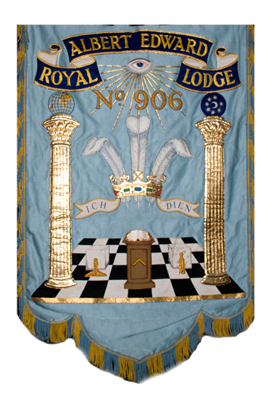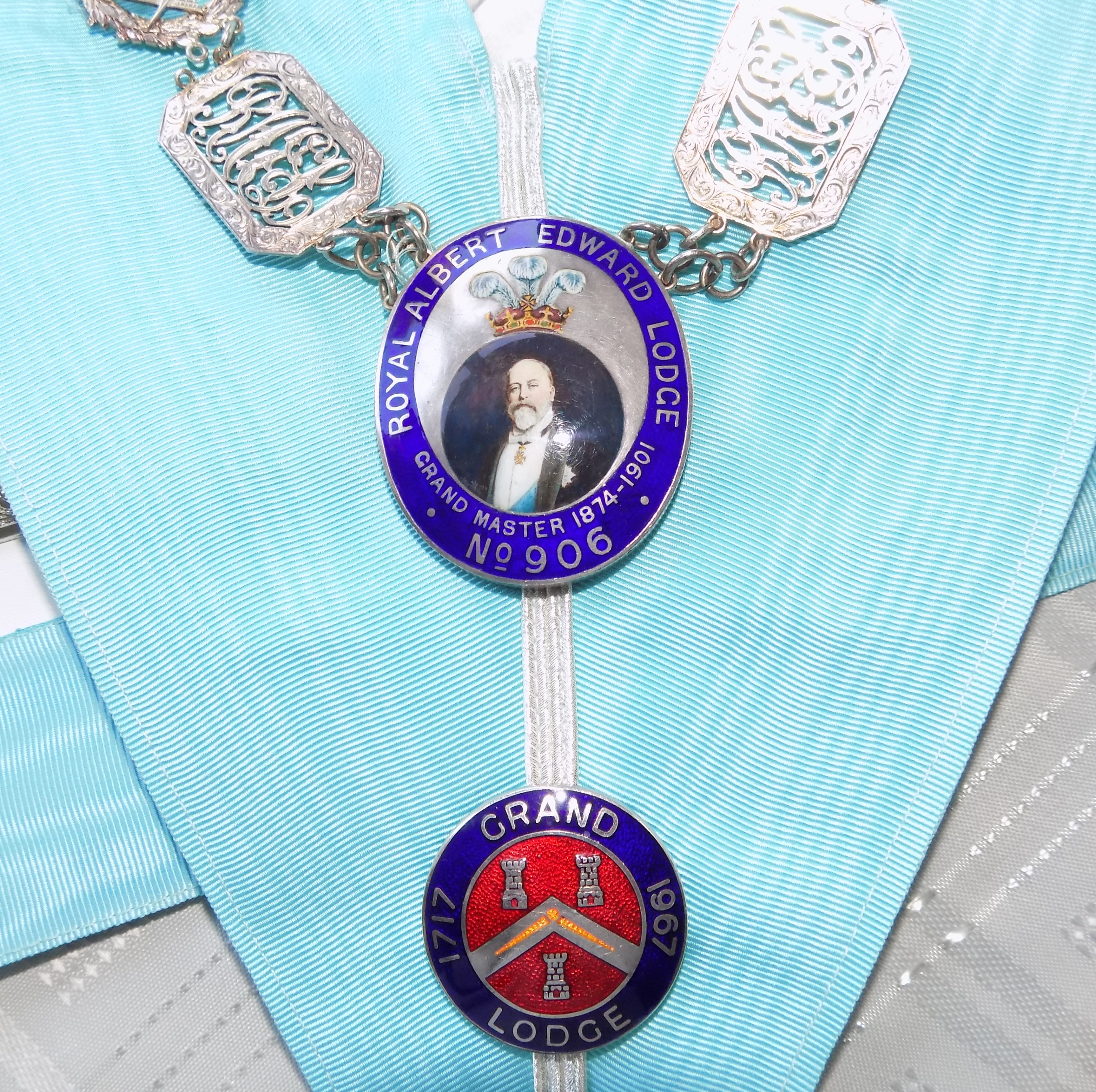On the 25th July of 1861, five Officers, one Past Master and two Master Masons, all members of the Royal Cumberland Lodge 48 (now No.41) met at the Christopher Hotel in Bath to consider establishing a new Masonic Lodge in one of the villages in the neighbourhood of Bath.
Over the following months the proposal gained much support and in consequence it was proposed and seconded that a warrant be applied for to hold a Lodge at the Lamb & Lark Inn at Keynsham, called the ‘Royal Albert Edward’, and that it should only meet in the summer months of June, July, August and September.
The warrant was granted and the first meeting of the Royal Albert Edward Lodge 1208 was held on 29th May 1862. The Chair was occupied by Thomas Broadwood Moutrie of the Royal Cumberland Lodge. In response to the toast to the Worshipful Master, he said that when installed as Master of Royal Cumberland, the oldest Lodge in the Province, he thought he had attained the summit of his ambition. He now felt he had achieved still more in being the first Master of the youngest. W. Bro Moutrie continued as Master for two years. In 1863, under the general Lodge renumbering across the country, the Lodge acquired its current number 906.
Lodge meetings were originally held on the second Wednesday of those four summer months, starting at the unusually late hour of 7.30pm. The reason for the late start was probably the lack of transport other than horse drawn vehicles, and it was not unusual for Brethren to walk considerable distances to attend their Lodge. Despite the late start, it was common for two, sometimes three, different degrees to be conferred in one evening.
Because of its village location, the Royal Albert Edward Lodge built up its own complete set of Craft furniture. This was thanks, in part, to the generosity of its members, but in particular to W.Bro Charles Beckett, a Founding Member, who was conveniently the proprietor of I Beckett & Sons, a firm of furniture manufacturers based in Bath, and who supplied most of the furniture. Much of this furniture is still in use today by the Lodges and Degrees who meet at the Bath Masonic Hall and several other items are on display in the museum in the basement of the Hall.
The Lodge continued to meet at the Lamb & Lark until 1867 when, because of the frequent change of landlord and unpleasantness to which the Brethren were subjected, it became imperative to find other accommodation. On 14th June 1867, the first meeting was held at the Crown and Anchor Inn at Upper Weston, and the Lodge continued to meet there for 24 another years.
However, in December 1890, a meeting of Past Masters felt that from various circumstances that had arisen, the time had arrived when steps should be taken to move again. It was proposed that the Lodge move to the Bath Masonic Hall, and that negotiations be entered into to carry this into effect. As a result, members of the Lodges already meeting at the Hall were balloted, and the result was in favour. On 21st February 1891 the move was achieved thanks, in part, to W Bro I Stuckey who “very generously offered to provide the horses and van required for the removal of effects to Bath.”
The first meeting in the new location took place on 30th March 1891, and the Lodge has been meeting there ever since. Royal Albert Edward Lodge remained a summer Lodge until 1906 when, because of meagre numbers and the recognition that it was no longer a country Lodge, it was unanimously agreed to change the meeting months to September through to April, omitting December.
In 1920, a daughter Lodge was consecrated ; the founding Master was W Bro William Brake. It was originally intended that the new Lodge be called the William Long Lodge – William Long was the Provincial Grand Master – but it eventually received its present title of St Alphege No.4095. It was decided that the new Lodge should meet on a Saturday, being founded principally for commercial travellers who were invariably away from home during the week.
Being the daughter Lodge of Royal Cumberland, and using their ritual and mode of working, it was believed that the Royal Albert Edward Lodge had also inherited their traditions and privileges. Consequently, the use of the illuminated star in place of the Master’s Light in the third degree was enjoyed for a period of 76 years. However, in 1938 the irregularity of its use was pointed out by Grand Lodge and although strenuous efforts were made to retain it, in loyalty to Grand Lodge it was reluctantly discontinued. More recently, approval was given for the Lodge Stewards to continue wearing their traditional red aprons and collars.
In 1940 the Lodge was asked to sponsor a Lodge of Instruction for the benefit of Freemasons among Admiralty staff evacuated from London to Bath during World War II. This was agreed and supported by Province “provided that at least two Past Masters from the Royal Albert Edward be present at each meeting”. This Lodge of Instruction was titled the Royal Albert Edward Lodge (Admiralty Section). In due course, and in response to requests by the Lodge of Instruction, dispensation was obtained for the Royal Albert Edward Lodge to hold an Emergency Meeting to discuss the formation of a new Lodge, primarily for the benefit of the Admiralty Masons, and as a result a petition was submitted to Grand Lodge. This was successful and St Luke’s Lodge No 6540 was consecrated later in 1947.
Over the weekend of 25–27 April 1942, Bath suffered three bombing raids, during which the Masonic Hall was severely damaged, rendering it unusable. As a result, the Lodge meetings temporarily returned to Keynsham – but this time to the Masonic Hall there, rather than the Lamb and Lark Inn. Special dispensation to hold the meeting in Keynsham was again obtained in September 1949 to allow the war damage to the Bath hall to be properly repaired. Members of the Lodge have served this country with distinction during both World Wars, several receiving high awards.
Over the past 160 years, not only has the Royal Albert Edward Lodge served the cause of Freemasonry with distinction, but its members have also made notable contributions to the civic life of the City of Bath. Six members of this Lodge have served as Mayor of the City – W.Bro A. W. Wills in 1918, W.Bro L. G. Adams in 1937, Bro Edward Taylor OBE in 1946, W.Bro R. W. Pearson in 1951, Bro A. C. Knight in 1960 and W.Bro R. E. Tucker in 1961.
The Lodge has been honoured five times by the Grand Lodge of England – including W.Bro Edward Brake promoted to PAGStdB in 1931, W.Bro W A Gayner promoted to PAGDC in 1940 and his son W.Bro A E (Eddy) Gayner who was promoted to PGStB in 1981. W.Bro Eddy devoted much of his life to Freemasonry and will be remembered in particular for his hard work and commitment in establishing our renowned Masonic Museum now located in the basement.
The Lodge currently has two Grand Officers – W.Bro John Pearson PJGD (son of the 87th Master) and V.W.Bro Denis Calderley PGSwdB. V.W.Bro Denis served with great distinction as the Holy Royal Arch Provincial Grand Superintendant in and over the Province of Somerset from 1998 to 2008. In total he served 19 continuous years in high office and in recognition of his exceptional contribution to the Holy Royal Arch, a new Chapter was consecrated on 7th April 2011 and given the name the Calderley Chapter of Union No 906.
Unusually, three generations of one family served as Master of the Royal Albert Edward Lodge. W.Bro Jesse Hayward was installed 1890, followed by his son W.Bro George Hayward in 1913 and then by his grandson W.Bro Jack Hayward in 1938. It was W.Bro Jack Hayward who officiated at the Centenary Celebration Meeting, which took place on 29th May 1963.
More recently the Past PGM, V.W.Bro David Jenkins, presented two Brethren of this Lodge, who were consecutive Initiates in December 1955 & January 1956, with 50th Anniversary Certificates. They were W.Bro John Pearson PJGD and W.Bro L J Cottell PPr.GSofWks who between them and their fathers have so far contributed an astonishing 225 years of membership and service to this Lodge.
Sadly, it has not been positively established how the Lodge came by its name. The most likely explanation has come from W.Bro Hamill, Librarian and Curator of the United Grand Lodge Library and Museum who has suggested that since seven of the eight brethren who sponsored the original petition were from the Royal Cumberland Lodge, which in 1786 took its name from HRH Henry Frederick, Duke of Cumberland, Grand Master from 1782 – 1790, and the other petitioner was from the Royal Sussex Lodge, which took its name in 1817 in honour of HRH Augustus Frederick, Duke of Sussex, Grand Master 1813 – 1843, then what better, than to name the Lodge “Royal Albert Edward” in honour of the Prince of Wales. He was then 21 years old, and it would be a further six years before he was initiated into Freemasonry (in Stockholm) and thirteen years before he was installed as Grand Master at the Royal Albert Hall in front of the largest assembly of Freemasons that had ever met at that time.




